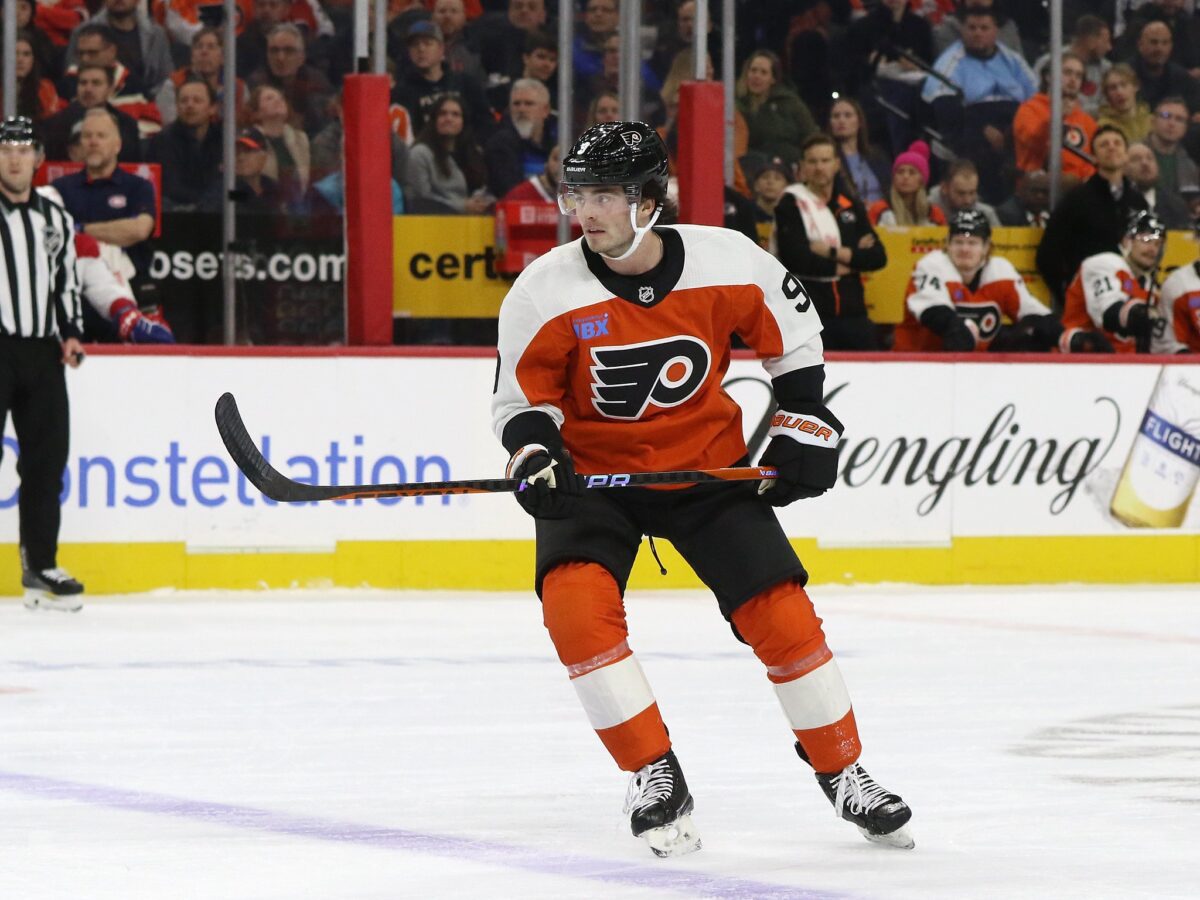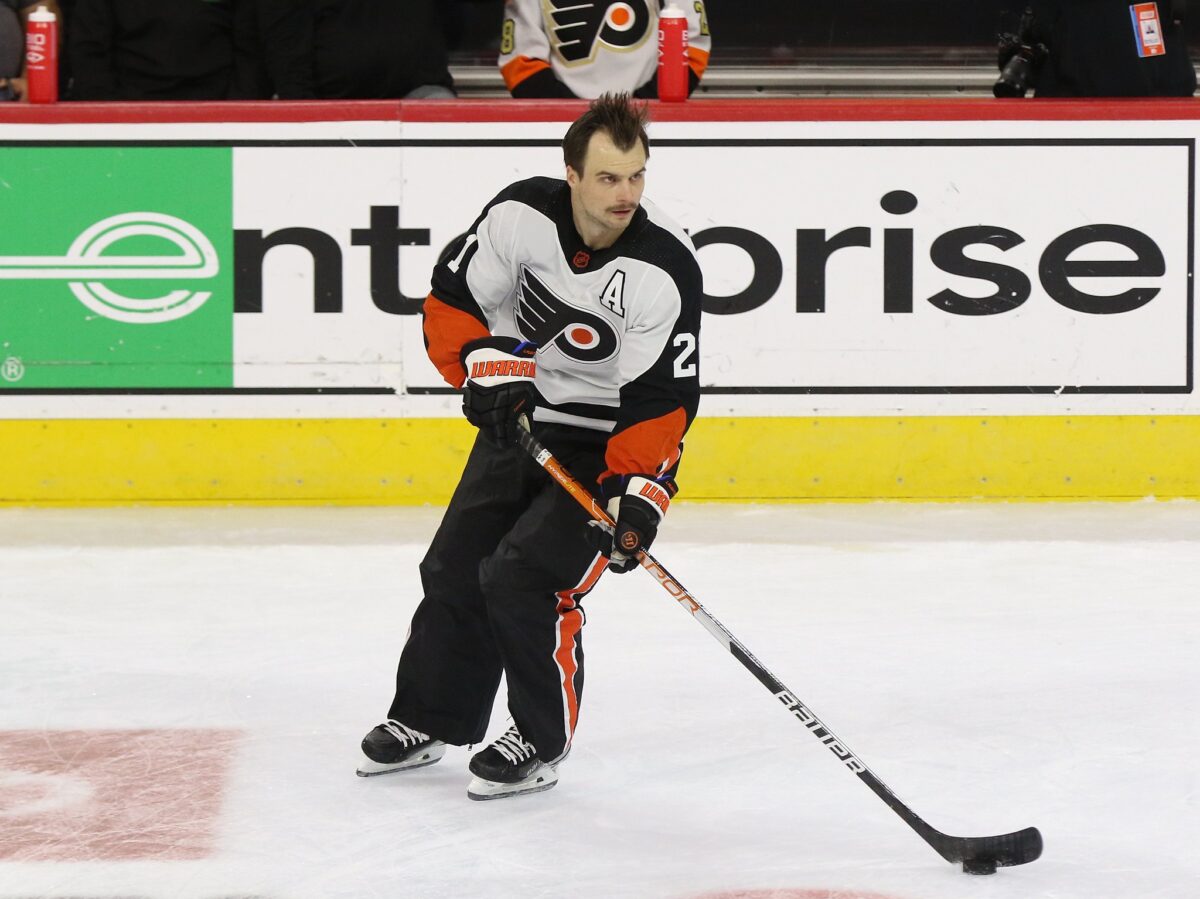The Philadelphia Flyers are entering their 2024-25 season with generally low expectations despite barely missing the playoffs in their most recent campaign and adding prospect Matvei Michkov to their roster. As well, they’re destined to have a few bounce-back candidates. Who might those players be?
Sean Couturier would be a worthy candidate to include here, but I already covered him in pretty lengthy detail. With that out of the way, who are three of the likeliest players to improve for the Orange and Black in 2024-25?
Jamie Drysdale
Jamie Drysdale is a candidate who seems bound to improve for the Flyers for a lot of reasons. From being traded in the middle of the season to battling through injury through his entire 2023-24 campaign, it just seems like destiny that he will get better. He’s also just 22 years old and has an immense level of skill that can help him become a potentially elite defenseman in the future. For now, let’s focus on the present.

Traded to the Flyers on Jan. 8, 2024, it wasn’t exactly an easy situation for Drysdale to come into. In a playoff spot at the time despite being seen as having one of the worst on-paper rosters in the league by some, Philadelphia played a specific style of defense that they weren’t really able to help the youngster adapt to right away. There were some growing pains, and that was especially the case because he was dealing with a sports hernia the entire time.
Related: Flyers 2023-24 Player Grades: Jamie Drysdale
Playing injured is something that can devastate a young athlete in terms of production, and that is especially the case when they are entering a unique situation. Even then, his numbers were actually fairly solid when he was paired with one player on the second pairing: Nick Seeler.
Based on how much they played together toward the end of the season, we can be somewhat confident that Drysdale will play most of his minutes—at least to start out—with the 31-year-old veteran. But just how much does that matter? Let’s compare Drysdale’s stats with and without who could be his defensive partner.
In the table below, we’ll look at some 5-on-5 numbers of Drysdale when he was with Seeler versus without him during his time with the Orange and Black. The metrics included are the following: expected goals for per 60 (xGF/60), expected goals against per 60 (xGA/60), expected goals percentage (xGF%), Corsi percentage (CF%), plus-minus, and time on ice (TOI). The meaning of some of the advanced metrics is described here. Now, here are the stats:
| Stat (5-on-5) | Drysdale with Seeler | Drysdale without Seeler (As a Flyer) |
| xGF/60 | 2.48 | 1.99 |
| xGA/60 | 2.25 | 2.68 |
| xGF% | 52.4 | 42.7 |
| CF% | 48.1 | 50.2 |
| Plus-minus | Minus-6 | Minus-10 |
| TOI | 104:28 | 261:37 |
Looking at the numbers, Drysdale was significantly better at both providing scoring chances and preventing them when he was with Seeler versus anyone else. The poor plus-minus rating has more to do with the Flyers’ struggling goaltending than anything, so the numbers on the left are definitely promising.
With these stats, what’s also important to note is that the two got better as time went on. Sean Walker was Seeler’s primary defensive partner, but being traded at the deadline opened up a lane for Drysdale to take his place. Once the latter two players returned from injury on April 1 and March 30 respectively, their on-ice stats were even better than what is listed above.
Based on the numbers, we should have a good level of confidence in Seeler to play like he did last season in 2024-25. Over the past two seasons, he has the highest xGF% (53.0) at 5-on-5 action among the Flyers’ major core of defensemen (Cam York, Travis Sanheim, and Rasmus Ristolainen) who played in both campaigns. He has been very consistent of late, so regression at this time seems unlikely.
Getting back to Drysdale, having a player like this should be advantageous to him over a full season. Seeler blocks a ton of shots, can move the puck relatively well, and does not shy away from the physical side of the game. This duo has a ton of potential, and that much can be realized in the fall.
Scott Laughton
Scott Laughton, 30 years old, has been a member of the Flyers for his entire career—he has never had quite as disappointing of a season as he did in 2023-24. Based on both the eye test and the stats test, he just wasn’t up to par with what the Orange and Black needed from him.

Still, there should be some hope for Laughton. Not only should he still be young enough to see a return to form, but we have a plethora of evidence to suggest his 2023-24 campaign was a one-off—he sunk from a pretty good third-line player for his entire career to play that really didn’t deserve to be in the Flyers’ lineup at all. The numbers back up these claims.
To assess Laughton, we will use the following stats at 5-on-5 play only: points per 60 (P/60), relative xGF/60 (xGF/60 Rel), relative xGA/60 (xGA/60 Rel), relative xGF% (xGF% Rel), relative CF% (CF% Rel), relative goals percentage (GF% Rel), and average time on ice (ATOI). The “relative” numbers here are similar to the ones we used before, but are used to compare players to their teammates instead of just using rate metrics—they paint a picture as to how valuable someone is, essentially.
For these stats, we’ll look at Laughton’s three-year average from his 2020-21 season through 2022-23. Then, we’ll compare that to how he did in 2023-24 in those metrics. The last column in the table below looks at his change in percentile among all forwards in the NHL during those specific time periods. There’s definitely a theme that we see:
| Stat (5-on-5) | Laughton’s Previous 3-Year Average (2020-2023) | Laughton in 2023-24 | Percentile (All Forwards) |
| P/60 | 1.41 | 1.36 | 50th to 44th |
| xGF/60 Rel | 0.19 | Minus-0.50 | 77th to 25th |
| xGA/60 Rel | 0.03 | 0.59 | 39th to 4th |
| xGF% Rel | 1.71 | Minus-10.8 | 72nd to 8th |
| CF% Rel | Minus-0.58 | Minus-8.10 | 53rd to 11th |
| GF% Rel | 2.01 | Minus-7.88 | 69th to 32nd |
| ATOI | 13:19 | 11:52 | 84th to 55th |
Laughton went from above-average usage at 5-on-5 and putting up very respectable on-ice stats to average usage and some of the worst on-ice stats in the league. Even decreasing his average point totals, it’s evident that we’re looking at two different versions of a player here. Before last season, he was a really capable middle-six player—he arguably wasn’t a capable NHLer in 2023-24.
The good news here is that there is simply too much evidence to suggest that Laughton is closer to being a net positive to a third line versus an on-ice liability. The difference between those two might not seem like a lot, but it can be devastating to a team’s stats in reality. In Laughton’s case, it was—the Flyers were far worse offensively and defensively when he was on the ice.
Simply improving seems to be an easy bar to clear for Laughton, but there should be hope that he can be significantly better in 2024-25. He shouldn’t be expected to have a career year or anything, but being the player of old would be a nice start. Again, it might not seem like a lot, but on-ice improvement this large can seriously help a team.
Sam Ersson
It’s hard to think of a Flyer who went from hero to zero more quickly than Sam Ersson. The 24-year-old rookie backup goaltender had a legitimate case to be a finalist for the Calder Trophy after emerging as the team’s main starter from November until the end of the season. He put up excellent numbers at the start, but that faded hastily when his workload was dramatically increased to put him in the 92nd percentile of TOI among netminders across the league after Jan. 20.
We’ll look at two splits from Ersson, one before he was made the high-end, full-time starter and one after it. Save percentage (SV%), goals-against average (GAA), goals saved above average (GSAA), goals saved above expected (GSAx), and TOI will be the stats included as well as where Ersson ranked percentile-wise among all goaltenders during those specific stretches. Just like with Drysdale and Laughton, it’s a night-and-day difference:
| Stat | Ersson Before Jan. 21 | Ersson After Jan. 20 | Percentile (All Goalies) |
| SV% | .911 | .875 | 65th to 21st |
| GAA | 2.28 | 3.23 | 87th to 34th |
| GSAA | 3.70 | Minus-19.3 | 74th to 1st |
| GSAx | 6.53 | Minus-13.3 | 81st to 1st |
| TOI | 1212:30 | 1596:58 | 62nd to 92nd |
Ersson was put into an impossible situation for a rookie goaltender. His season-long stats plummeted to some of the worst in the NHL because he just wasn’t ready for a workload only comparable to established elite goaltenders like Juuse Saros, Connor Hellebuyck, and others. Unfortunately, this was really the only option that the Flyers had.
Behind Ersson, the Flyers didn’t have a single NHL-caliber goaltender to start games and give him rest. The only other netminders they had, Cal Petersen and Felix Sandstrom, were below-average in the American Hockey League (AHL)—playing high-end backup minutes (or really any at all) in the NHL was simply not going to fly.
During his first three months of the season, Ersson had a nice thing going. He was more or less starting every other game and got adequate rest. Of course, the situation changed and so the Flyers had to improvise—the result was cataclysmic.
Entering the 2024-25 season, the Flyers’ backup goaltender is set to be Ivan Fedotov, who they brought over from the Kontinental Hockey League (KHL) at the end of the season. His numbers weren’t great (.811 SV%), but that’s really not surprising. He missed his entire 2022-23 campaign due to military service, so he played a full starter’s role in 2023-24, the postseason, and came to the Flyers within one season—all completely raw.
It’s a lot to ask for a player to return to form after not playing hockey for that long. Having to adjust to the North American game after completing an entire KHL season was just not going to happen within two weeks—he was destined to fail the second he debuted on April 1, 2024.
Now with a season of playing hockey under his belt and an entire offseason to adapt to his new life, expectations should be a little bit higher for Fedotov. Seeing as the Flyers’ non-Ersson goaltenders had a combined .889 SV%, they’d need their new backup to be one of the worst in the NHL to regress on that front. Almost making the playoffs even with this subpar play between the pipes, an upgrade could go a long way.
Even if Fedotov isn’t impressive, his presence alone should help Ersson play at his best. If the latter can get some rest instead of playing essentially every game, it should allow his starts to be better. In the case of Ersson, quality is always above quantity—getting Fedotov in the net should be beneficial regardless.
The Flyers’ 2024-25 season should be a fun one, especially with a few key players seeming very likely to improve. Expectations aren’t incredibly high for them, but these three can help change that.
Stats courtesy of Natural Stat Trick